
Drop in between 10:30 am – 1:00 pm on the first SATURDAY of the month to enjoy special activities for families plus all of our regular museum programming, Raising Big Blue movie, museum tours, and more!
These drop-in sessions are designed for children 5-12 years old accompanied by an adult (not suitable for preschool-aged children). All sessions will be held at the Beaty Biodiversity Museum, with experts from the Pacific Museum of Earth and around UBC making guest appearances. Drop-in activities will run between 10:30 am and 1:00 pm.
Everyone is welcome to participate! Thanks to the generous support of Campus and Community Planning, UBC campus families can take part for free! UBC Campus Families are families of anyone who lives at UBC Vancouver or UBC Okanagan or is a staff, faculty, or student on either campus. Other families are welcome to join us, and museum admission rates apply.
Pre-register below to guarantee your spot at these activities!
To be notified of future nature club sessions, please sign up for the museum’s newsletter.


Fish have a backbone, live in water and breathe using special organs called gills. Fishing to find out more? Join us as we explore the diversity of fishes and take a closer look at fish in our collection.
The collection holds over 800,000 specimens and over 50,000 DNA and tissue samples, making it the third-largest fish collection in Canada. The collection holds 11 holotype specimens, original specimens that were used to describe new species. It also contains representatives of what may be the youngest fish species on Earth: pairs of stickleback species that evolved only recently in British Columbia’s lakes.
Registration
Nature Club is free for UBC Families and Members. Museum admission rates apply for the general public. If you would like to pre-book your visit, please register below and check in at our admissions desk to purchase your tickets.

Join us as we take a closer look at the non-plant specimens from the herbarium. This includes some fabulous fungi - learn a bit more about mushrooms, from the parts we see to the vast networks beneath our feet. Algae are photosynthetic and are a diverse group of aquatic organisms, ranging from single cells to kelps 60 metres long. We’ll also look at lichens, symbiotic associations between certain types of fungi and algae, working together to form a structure and photosynthesize food.
The herbarium at the museum contain over 90,000 algae specimens, 45,000 lichens and 25,000 other fungi—but the diversity of fungi and lichens is only partly understood, even in the Lower Mainland, with many new species still to be discovered!
Registration
Nature Club is free for UBC Families and Members. Museum admission rates apply for the general public. If you would like to pre-book your visit, please register below and check in at our admissions desk to purchase your tickets.

This month we are learning more about some of our favourite egg-laying tetrapods, the birds, reptiles, and amphibians! Join us as we explore their vast diversity of body shapes, lifestyles, and adaptations.
Visit the Cowan Tetrapod collection at the Beaty Museum to see birds, as well as reptiles, mammals and amphibians. With over 40,000 specimens representing over 2,500 species, the collection is the second-largest scientific collection of birds, mammals, reptiles, and amphibians in British Columbia.
Registration
Nature Club is free for UBC Families and Members. Museum admission rates apply for the general public. If you would like to pre-book your visit, please register below and check in at our admissions desk to purchase your tickets.

Join us and learn more about this amazing group of marine creatures that live without backbones. We will explore the world of molluscs, sea stars, crustaceans, sponges, jellyfish, and corals, just to name a few!
Our museum collection contains several thousand specimens representing the major lineages of invertebrate animals. Since this collection has so many different groups of organisms, we will feature this large group twice during Nature Club – both dates will have different activities!
Registration
Nature Club is free for UBC Families and Members. Museum admission rates apply for the general public. If you would like to pre-book your visit, please register below and check in at our admissions desk to purchase your tickets.

Entomology is the study of insects. This month we are taking a closer look at some interesting insects in the museum collection and learn more about the fascinating features of these organisms.
With over half a million pinned specimens, 75,000 alcohol-preserved specimens and 25,000 specimens on slides, a visit to the Spencer Entomological collection at the museum is your chance to see incredible insect diversity.
Registration
Nature Club is free for UBC Families and Members. Museum admission rates apply for the general public. If you would like to pre-book your visit, please register below and check in at our admissions desk to purchase your tickets.

Today we’ll explore the plants from the herbarium, including vascular plants and bryophytes. Bryophytes include mosses and liverworts; this curious group of plants do not produce any flowers and reproduce using spores instead of seeds. Plants like trees, shrubs, flowers, and ferns are known as vascular plants, which means they have inner structures that transport water, sugar, and nutrients around their bodies. Learn about new and familiar plants while we explore different groups and their features.
We are home to the largest herbarium in Canada, holding more than 650,000 vascular plant and 327,000 bryophyte specimens, some dating back as far as 1804. A herbarium is a museum of dried plant specimens. Herbaria provide a permanent record of our changing flora over time, documenting all plant species discovered so far, their variation, and their past and present distributions. These specimens also hold a treasure trove of anatomical, chemical, ethnobotanical, and molecular information, and document the history of plant exploration.
Registration
Nature Club is free for UBC Families and Members. Museum admission rates apply for the general public. If you would like to pre-book your visit, please register below and check in at our admissions desk to purchase your tickets.
October 5, 2024: Mammals

Mammals are a group of warm-blooded animals with backbones and include musk ox, humans and blue whales! Find out more about the characteristics that link us together.
Visit the Cowan Tetrapod collection at the Beaty Museum to see birds, as well as reptiles, mammals and amphibians. With over 40,000 specimens representing over 2,500 species, the collection is the second-largest scientific collection of birds, mammals, reptiles, and amphibians in British Columbia.
November 2, 2024: Marine Invertebrates

Join us and learn more about this amazing group of marine creatures that live without backbones. We will explore the world of molluscs, sea stars, crustaceans, sponges, jellyfish, and corals, just to name a few!
Our museum collection contains several thousand specimens representing the major lineages of invertebrate animals. Since this collection has so many different groups of organisms, we will feature this large group twice during Nature Club – both dates will have different activities!
December 7, 2024: Fossils
 Fossils are the preserved remains or traces of plants and animals. They can tell us about ancient life on earth and help us understand present-day biodiversity. Interested in seeing fossils at the museum?
Fossils are the preserved remains or traces of plants and animals. They can tell us about ancient life on earth and help us understand present-day biodiversity. Interested in seeing fossils at the museum?
The fossil collection was started in 1924 and contains over 20,000 specimens! Join us as we learn more about different types of fossils, how they are made, and what we can learn from them.
October 7, 2023: Fossils
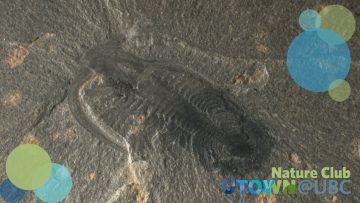 Fossils are the preserved remains or traces of plants and animals. They can tell us about ancient life on earth and help us understand present-day biodiversity. Interested in seeing fossils at the museum?
Fossils are the preserved remains or traces of plants and animals. They can tell us about ancient life on earth and help us understand present-day biodiversity. Interested in seeing fossils at the museum?
The fossil collection was started in 1924 and contains over 20,000 specimens! Join us as we learn more about different types of fossils, how they are made, and what we can learn from them.
Interested in learning more about fossils from home?
-
- Learn more about different types of fossils and how they are formed.
- Geological processes over time have had a significant impact on life on Earth. Our friends at the Pacific Museum of Earth share stories from the Department of Earth, Ocean and Atmospheric Sciences at UBC. You can explore their museum virtually here.
November 4, 2023: Fungi & Lichen
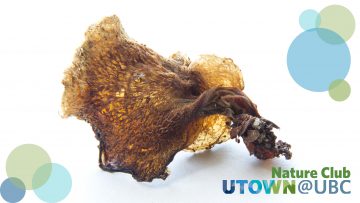
Join us as we take a closer look at some fabulous fungi from the museum collection and learn a bit more about mushrooms, from the parts we see to the vast networks beneath our feet. We’ll also look at lichens, symbiotic associations between certain types of fungi and algae, working together to form a structure and photosynthesize food.
The fungal and lichen collections at the museum contain roughly 70,000 specimens—45,000 lichens and 25,000 other fungi—but the diversity of fungi and lichens is only partly understood, even in the Lower Mainland, with many new species still to be discovered!
December 2, 2023: Mammals
 Mammals are a group of warm-blooded animals with backbones and include musk ox, humans, and blue whales! Find out more about the characteristics that link us together.
Mammals are a group of warm-blooded animals with backbones and include musk ox, humans, and blue whales! Find out more about the characteristics that link us together.
Visit the Cowan Tetrapod collection at the Beaty Museum to see birds, as well as reptiles, mammals, and amphibians. With over 40,000 specimens representing over 2,500 species, the collection is the second-largest scientific collection of birds, mammals, reptiles, and amphibians in British Columbia.
January 6, 2023: Entomology
 Entomology is the study of insects. This month we are taking a closer look at some interesting insects in the museum collection and learning more about the fascinating features of these organisms.
Entomology is the study of insects. This month we are taking a closer look at some interesting insects in the museum collection and learning more about the fascinating features of these organisms.
With over half a million pinned specimens, 75,000 alcohol-preserved specimens and 25,000 specimens on slides, a visit to the Spencer Entomological collection at the museum is your chance to see incredible insect diversity.
Alongside drop-in style activities, this month, we're hosting mini-workshops in the Discovery Lab!
Join one of the mini-workshops on Insect Magnification for Beginners at 11:00, 11:30, 12:00, or 12:30. We’ll discuss different tools that entomologists use to magnify insects. We’ll lead you through the steps to use a stereo/dissecting microscope and you can try it out (for ages 5+). Magnifying glasses will be available to use for younger scientists. Mini workshops are first-come, first-serve.
February 3, 2024: Marine Invertebrates
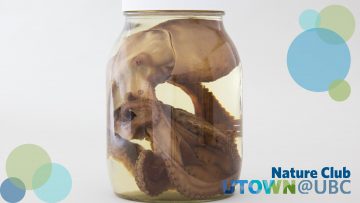 Join us and learn more about this amazing group of marine creatures that live without backbones. Our museum collection contains several thousand specimens representing the major lineages of invertebrate animals. We will explore the world of molluscs, sea stars, crustaceans, sponges, jellyfish, and corals, just to name a few!
Join us and learn more about this amazing group of marine creatures that live without backbones. Our museum collection contains several thousand specimens representing the major lineages of invertebrate animals. We will explore the world of molluscs, sea stars, crustaceans, sponges, jellyfish, and corals, just to name a few!
March 2, 2024: Bryophytes & Algae
 Bryophytes include mosses and liverworts; this curious group of plants does not produce any flowers and reproduces using spores instead of seeds. Algae are photosynthetic and are a diverse group of aquatic organisms, ranging from single cells to kelps 60 metres long. Join us to learn about these beautiful organisms commonly found in the Lower Mainland!
Bryophytes include mosses and liverworts; this curious group of plants does not produce any flowers and reproduces using spores instead of seeds. Algae are photosynthetic and are a diverse group of aquatic organisms, ranging from single cells to kelps 60 metres long. Join us to learn about these beautiful organisms commonly found in the Lower Mainland!
With over 90,000 algae specimens and 327,000 bryophyte specimens, we have one of the largest and most comprehensive Pacific Northwest bryophyte collections!
April 6, 2024: Birds, Reptiles, and Amphibians
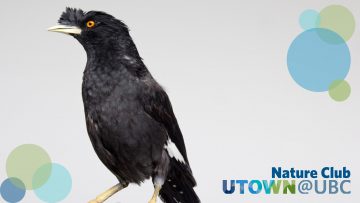 This month we are learning more about some of our favourite egg-laying tetrapods, birds, reptiles, and amphibians! Join us as we explore their vast diversity of body shapes, lifestyles, and adaptations.
This month we are learning more about some of our favourite egg-laying tetrapods, birds, reptiles, and amphibians! Join us as we explore their vast diversity of body shapes, lifestyles, and adaptations.
Visit the Cowan Tetrapod collection at the Beaty Museum to see birds, as well as reptiles, mammals, and amphibians. With over 40,000 specimens representing over 2,500 species, the collection is the second-largest scientific collection of birds, mammals, reptiles, and amphibians in British Columbia.
May 4, 2024: Fish

Fish have a backbone, live in water, and breathe using special organs called gills. Fishing to find out more? Join us as we explore the diversity of fishes and take a closer look at fish in our collection.
The Fish Collection holds over 800,000 specimens and over 50,000 DNA and tissue samples, making it the third-largest fish collection in Canada. The collection holds 11 holotype specimens, original specimens that were used to describe new species. It also contains representatives of what may be the youngest fish species on Earth: pairs of stickleback species that evolved only recently in British Columbia’s lakes.
June 1, 2024: Vascular Plants
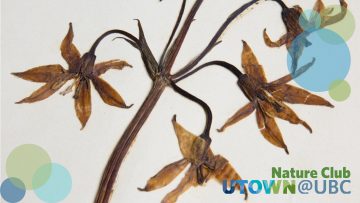 Plants like trees, shrubs, flowers, and ferns are known as vascular plants, which means they have inner structures that transport water, sugar, and nutrients around their bodies. Learn about new and familiar plants while we explore different groups and their features.
Plants like trees, shrubs, flowers, and ferns are known as vascular plants, which means they have inner structures that transport water, sugar, and nutrients around their bodies. Learn about new and familiar plants while we explore different groups and their features.
The diversity of local plant life is important to all life around us. Would you like to learn a new local plant or celebrate one you already know? During our Vascular Plant Nature Club, join Nancy at 10:45 or 11:45 am for an outdoor plant observation walk around the museum. Along with her plant walks, you'll find activity stations led by volunteers, staff, and special guests! Check-in at the admissions desk when you arrive, and they will direct you to the start of our timed sessions and the location of our other drop-in stations.
Nancy will introduce the tour and craft, everyone will “gear up” for making observations, and discuss topics like vascular vs. nonvascular plants. Our walk will focus on vascular plants in flower or fruit at the museum. After the walk and observation, you can create your own rock art to take home and help you remember your chosen plant friend and perhaps find that plant species on another walk. Please dress for the weather. This outdoor walk will run rain or shine. Children under 12 years must be accompanied by an adult in the museum and outdoor museum activities.
We are home to the largest herbarium in Western Canada, holding more than 650,000 specimens, some dating back as far as 1804. A herbarium is a museum of dried plant specimens. Herbaria provide a permanent record of our changing flora over time, documenting all plant species discovered so far, their variation, and their past and present distributions. These specimens also hold a treasure trove of anatomical, chemical, ethnobotanical, and molecular information, and document the history of plant exploration.
October 1, 2022: Entomology
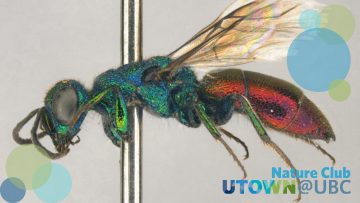 Entomology is the study of insects. This month we are taking a closer look at some interesting insects in the museum collection and learning more about the fascinating features of these organisms.
Entomology is the study of insects. This month we are taking a closer look at some interesting insects in the museum collection and learning more about the fascinating features of these organisms.
With over half a million pinned specimens, 75,000 alcohol-preserved specimens and 25,000 specimens on slides, a visit to the Spencer Entomological collection at the museum is your chance to see incredible insect diversity.
November 5, 2022: Bryophytes and Algae
 Bryophytes include mosses and liverworts; this curious group of plants does not produce any flowers and reproduces using spores instead of seeds. Algae are photosynthetic and are a diverse group of aquatic organisms, ranging from single cells to kelps 60 metres long. Join us to learn about these beautiful organisms commonly found in the Lower Mainland!
Bryophytes include mosses and liverworts; this curious group of plants does not produce any flowers and reproduces using spores instead of seeds. Algae are photosynthetic and are a diverse group of aquatic organisms, ranging from single cells to kelps 60 metres long. Join us to learn about these beautiful organisms commonly found in the Lower Mainland!
With over 90,000 algae specimens and 327,000 bryophyte specimens, we have one of the largest and most comprehensive Pacific Northwest bryophyte collections!
December 3, 2022: Marine Invertebrates
 Join us and learn more about this amazing group of marine creatures that live without backbones. Our museum collection contains several thousand specimens representing the major lineages of invertebrate animals. We will explore the world of molluscs, sea stars, crustaceans, sponges, jellyfish, and corals, just to name a few!
Join us and learn more about this amazing group of marine creatures that live without backbones. Our museum collection contains several thousand specimens representing the major lineages of invertebrate animals. We will explore the world of molluscs, sea stars, crustaceans, sponges, jellyfish, and corals, just to name a few!
January 7, 2023: Fungi and Lichen

Join us as we take a closer look at some fabulous fungi from the museum collection and learn a bit more about mushrooms, from the parts we see to the vast networks beneath our feet. We’ll also look at lichens, symbiotic associations between certain types of fungi and algae, working together to form a structure and photosynthesize food.
The fungal and lichen collections at the museum contain roughly 70,000 specimens—45,000 lichens and 25,000 other fungi—but the diversity of fungi and lichens is only partly understood, even in the Lower Mainland, with many new species still to be discovered!
February 4, 2023: Birds, Reptiles, and Amphibians
 This month we are learning more about some of our favourite egg-laying tetrapods, birds, reptiles, and amphibians! Join us as we explore their vast diversity of body shapes, lifestyles, and adaptations.
This month we are learning more about some of our favourite egg-laying tetrapods, birds, reptiles, and amphibians! Join us as we explore their vast diversity of body shapes, lifestyles, and adaptations.
Visit the Cowan Tetrapod collection at the Beaty Museum to see birds, as well as reptiles, mammals and amphibians. With over 40,000 specimens representing over 2,500 species, the collection is the second-largest scientific collection of birds, mammals, reptiles, and amphibians in British Columbia.
March 4, 2023: Mammals
 Mammals are a group of warm-blooded animals with backbones and include musk ox, humans and blue whales! Find out more about the characteristics that link us together.
Mammals are a group of warm-blooded animals with backbones and include musk ox, humans and blue whales! Find out more about the characteristics that link us together.
Visit the Cowan Tetrapod collection at the Beaty Museum to see birds, as well as reptiles, mammals and amphibians. With over 40,000 specimens representing over 2,500 species, the collection is the second-largest scientific collection of birds, mammals, reptiles, and amphibians in British Columbia.
April 1, 2023: Fish
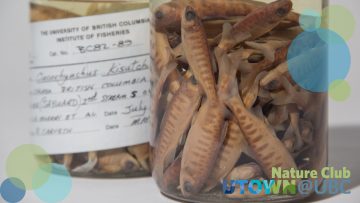 Fish have a backbone, live in water and breathe using special organs called gills. Fishing to find out more? Join us as we explore the diversity of fishes and take a closer look at fish in our collection.
Fish have a backbone, live in water and breathe using special organs called gills. Fishing to find out more? Join us as we explore the diversity of fishes and take a closer look at fish in our collection.
The Fish Collection holds over 800,000 specimens and over 50,000 DNA and tissue samples, making it the third-largest fish collection in Canada. The collection holds 11 holotype specimens, original specimens that were used to describe new species. It also contains representatives of what may be the youngest fish species on Earth: pairs of stickleback species that evolved only recently in British Columbia’s lakes.
May 6, 2023: Vascular Plants
 Plants like trees, shrubs, flowers, and ferns are known as vascular plants, which means they have inner structures that transport water, sugar, and nutrients around their bodies. Learn about new and familiar plants while we explore different groups and their features.
Plants like trees, shrubs, flowers, and ferns are known as vascular plants, which means they have inner structures that transport water, sugar, and nutrients around their bodies. Learn about new and familiar plants while we explore different groups and their features.
We are home to the largest herbarium in Western Canada, holding more than 650,000 specimens, some dating back as far as 1804. A herbarium is a museum of dried plant specimens. Herbaria provide a permanent record of our changing flora over time, documenting all plant species discovered so far, their variation, and their past and present distributions. These specimens also hold a treasure trove of anatomical, chemical, ethnobotanical, and molecular information, and document the history of plant exploration.
June 3, 2023: Fossils
 Fossils are the preserved remains or traces of plants and animals. They can tell us about ancient life on earth and help us understand present-day biodiversity. Interested in seeing fossils at the museum?
Fossils are the preserved remains or traces of plants and animals. They can tell us about ancient life on earth and help us understand present-day biodiversity. Interested in seeing fossils at the museum?
The Fossil Collection was started in 1924 and contains over 20,000 specimens! Join us as we learn more about different types of fossils, how they are made, and what we can learn from them.

October 2, 2021: Fish
Fish have a backbone, live in water and breathe using special organs called gills. Fishing to find out more? Join us as we explore the diversity of fishes and take a closer look at fish in our collection.
The collection holds over 800,000 specimens and over 50,000 DNA and tissue samples, making it the third-largest fish collection in Canada. The collection holds 11 holotype specimens, original specimens that were used to describe new species. It also contains representatives of what may be the youngest fish species on Earth: pairs of stickleback species that evolved only recently in British Columbia’s lakes.
Interested in learning more about fish at home?
-
- Researchers Revealed Video - In Search of Salmon
- Herring Colouring sheet
- Learn about the complex network of knowledge around the making of a sturgeon harpoon. This online exhibit is a collaboration with the Musqueam First Nation.
- How do you keep 800,000 fish specimens in order? Dr. Nicolas Bailly, Curatorial Assistant for the Fish Collection at the Beaty Biodiversity Museum, shares his experience in this video.

November 6, 2021: Fungi
Autumn has arrived, the air is getting cooler, the leaves are changing colour, and mushrooms are starting to appear. Want to learn more? Join us as we take a closer look at some fabulous fungi from the museum collection and learn a bit more about mushrooms, from the parts we see to the vast networks beneath our feet.
The fungal and lichen collections at the museum contain roughly 70,000 specimens—45,000 lichens and 25,000 other fungi—but the diversity of fungi and lichens is only partly understood, even in the Lower Mainland, with many new species still to be discovered!
Interested in exploring fungi from home?
- Spotted a mushroom? Our ‘Mushrooms Up’ guide will help you correctly identify your find.
- As you explore the fungi in your own backyard record your findings in a Nature Journal, given the amazing diversity of fungi, you are going to need some extra pages for your journal!
- Researchers Revealed Video - Fossilized fungi
 December 4, 2021: Fossils
December 4, 2021: Fossils
Fossils are the preserved remains or traces of plants and animals. They can tell us about ancient life on earth and help us understand present-day biodiversity. Interested in seeing fossils at the museum?
The fossil collection was started in 1924 and contains over 20,000 specimens! Join us as we learn more about different types of fossils, how they are made, and what we can learn from them.
Interested in learning more about fossils from home?
- Learn more about different types of fossils and how they are formed.
- Geological processes over time have had a significant impact on life on earth. Our friends at the Pacific Museum of Earth share stories from the Department of Earth, Ocean and Atmospheric Sciences at UBC. You can explore their museum virtually here.

January 8, 2022: Bryophytes
Bryophytes, a group of plants that include mosses and liverworts, are beautiful! Learn more about this curious group of plants that do not produce any flowers and reproduce using spores instead of seeds.
The museum is home to 327,000 specimens, making this one of the largest and most comprehensive Pacific Northwest bryophyte collections!
Interested in learning more about bryophytes in your own backyard?
- In this NEW worksheet created for this month's Nature Club, become a bryophyte detective! Join Laura, a LEEF student, to find her study site and identify three bryophytes! Download the worksheet by clicking here. You'll want to use your computer to help you!
- If you need bigger photos, you can find them here. And if you are stumped, use this answer guide for extra clues!
- Close observation is essential to appreciate the fine details of these intricate organisms, find a quiet spot in the collection and practice your careful looking and drawing skills using this worksheet.
- Rhizoid, liverwort, spores - there is a range of vocabulary to learn when you study bryophytes. Use this template to create a crossword puzzle using all your new words.
- Dr. Karen Golinski recently joined the Beaty Biodiversity Museum as Collections Curator – Bryophytes, Fungi & Lichens with the Herbarium. In this video, we get to know more about Karen, her research and her experience.
 February 5, 2022: Birds
February 5, 2022: Birds
This month we are learning more about our favourite feathered friends. Join us as we explore the diversity of bird bodies, shapes, and sizes.
Visit the Cowan Tetrapod collection at the Beaty Museum to see birds, as well as reptiles, mammals and amphibians. With over 40,000 specimens representing over 2,500 species, the collection is the second-largest scientific collection of birds, mammals, reptiles, and amphibians in British Columbia.
Interested in learning more about the birds in your backyard?
- Learn about bird flight with Vikram in this Researchers Revealed video
- Learn to identify local birds, keep track of your observations using this bird log.
- Chickadee colouring page
- In this activity, you will explore the form and function of different bird beak shapes.
 March 5, 2022: Marine Invertebrates
March 5, 2022: Marine Invertebrates
Join us and learn more about this amazing group of marine creatures that live without backbones. Our museum collection contains several thousand specimens representing the major lineages of invertebrate animals. We will explore the world of mollusks, starfish, sponges, jellyfish, and corals, just to name a few!
Exploring marine invertebrates from home?
- Krill colouring sheet.
- How to draw krill.
- In this video, Dr. Colin MacLeod, Curatorial Assistant for the Marine Invertebrate Collection, explains how, when the university and museum closed, he found a way to continue his research on parasites on marine invertebrates by setting up a mobile lab in his house.

April 2, 2022: Mammals
Mammals are a group of warm-blooded animals with backbones and include musk ox, humans and blue whales! Find out more about the characteristics that link us together.
Visit the Cowan Tetrapod collection at the Beaty Museum to see birds, as well as reptiles, mammals and amphibians. With over 40,000 specimens representing over 2,500 species, the collection is the second-largest scientific collection of birds, mammals, reptiles, and amphibians in British Columbia.
Interested in learning more about mammals from home?
- Researchers Revealed Video - Eyes in the Wild.
- Learn to identify some local mammals.
 May 14, 2022: Entomology
May 14, 2022: Entomology
Entomology is the study of insects. This month we are taking a closer look at some interesting insects in the museum collection and learn more about the fascinating features of these organisms.
With over half a million pinned specimens, 75,000 alcohol-preserved specimens and 25,000 specimens on slides, a visit to the Spencer Entomological collection at the museum is your chance to see incredible insect diversity.
Interested in learning more about entomology from home?
- Learn how to identify some local insects.
- Meet the Pollinators! In this video, Tiia Haapalainen from the Spencer Entomological Collection introduces you to some pollination basics, the major insect groups involved with pollination, and how to tell them apart (mimicry abounds!)
- Create your own origami butterflies.
 June 4, 2022: Flowering Plants
June 4, 2022: Flowering Plants
This month we will be looking closely at petals and exploring flowering plants, the group of plants that produce seeds, fruits, and flowers.
We are home to the largest herbarium in Canada, holding more than 650,000 specimens, some dating back as far as 1804. A herbarium is a museum of dried plant specimens. Herbaria provide a permanent record of our changing flora over time, documenting all plant species discovered so far, their variation, and their past and present distributions. These specimens also hold a treasure trove of anatomical, chemical, ethnobotanical, and molecular information, and document the history of plant exploration.
Interested in exploring the flowering plants in your own backyard?
- Learn how to identify some local plant species, and keep track of your findings in this plant log.
- Linda Jennings, Collections Curator Vascular Plants, created this video series about common backyard plants: Backyard Biodiversity Playlist.
- Test your knowledge of flower parts with this activity sheet.
